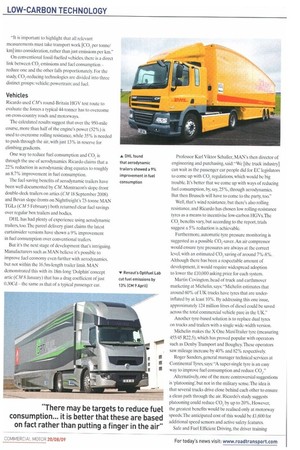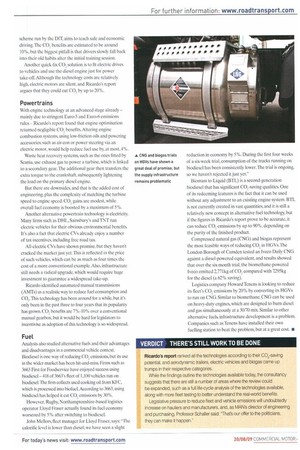ssions "131.
Page 46

Page 48

Page 49

If you've noticed an error in this article please click here to report it so we can fix it.
A report on low-carbon technologies for HGVs underpins the government's Low Carbon Transport Innovation Strategy on solutions for reducing CO2 emissions, but are the results practical?
Words: Ian Tonkin Road transport (including passenger cars and motorcycles) accounted for 22% of the UK's entire CO, emissions in 2007 but, unlike other industries such as energy supply and the business sector, emissions levels have been rising since 1990.
This figure comes from a report compiled by engineering consultancy Ricardo for the Department for Transport (MT), which aims to investigate, analyse and incentivise the take-up of low carbon technologies for HGVs.
Carbon trading is also set to become a reality, and from October, a voluntary carbon accounting system will be introduced by the Department for Environment, Food and Rural Affairs.
A cap-and-trade system has been suggested as a possible way to cut CO2. Businesses that produce more CO2 than they are allocated will have to buy credits, whereas companies that produce less can sell theirs.
According to the latest figures from the World Bank. the European Union's emissions trading scheme generated US$50bn (f30m), so going green could actually turn out to be lucrative for firms.
Ricardo technology and clean energy manager Nick Powell explains: 'We were asked to examine if you were looking at medium or heavy-duty vehicles -what are the most promising technologies to reduce carbon emissions, and how far into the future are they likely to come?"
Emissions targets Neville Jackson, Ricardo group technology director, adds: "At some point, there may be targets to reduce fuel consumption from this sector, and it is better that these are based on fact rather than just putting a finger in the air."
Ray Cattley, manager legislation and environment at Volvo Trucks UK, says: "The government has avoided any detailed discussions on incentives for low-carbon solutions for HGVs. Hopefully, they appreciate the improvements that the industry vehicle manufacturers and operators has made over the past few decades, while at the same time driving down emissions and [improving] air quality."
Currently, there are no mandatory European CO, targets for truck manufacturers to adhere to. But what about Euro-5 and Euro-6? Well, those directives focus more on limiting pollutants such as nitrogen oxide (N0x) and particulate emissions (PE) rather than CO,, so, in order for the DIT to table an incentive scheme for low-carbon HO Vs, it needed to grasp the fundamentals.
Urban Witstljung, public and environmental affairs at Scania Sweden, savs:"The authors have identified the key issues and made reasonable conclusions. "It is important to highlight that all relevant measurements must take transport work [CO2 per tonne/ km] into consideration, rather than just emissions per km."
On conventional fossil-fuelled vehicles, there is a direct link between CO, emissions and fuel consumption reduce one and the other falls proportionately. For the study, CO2-reducing technologies are divided into three distinct groups: vehicle; powertrain; and fuel.
Vehicles Ricardo used CM's round-Britain HGV test route to evaluate the forces a typical 44-tonner has to overcome on cross-country roads and motorways.
The calculated results suggest that over the 950-mile course, more than half of the engine's power (52%) is used to overcome rolling resistance, while 35% is needed to push through the air, with just 13% in reserve for climbing gradients.
One way to reduce fuel consumption and CO2 is DHL found through the use of aerodynamics. Ricardo claims that a that aerodynamic 22% reduction in aerodynamic drag equates to roughly trailers showed a 9% an 8.7% improvement in fuel consumption. improvement in fuel The fuel-saving benefits of aerodynamic trailers have consumption been well documented by CM. Montracon's slope-front double-deck trailers on artics (CM 18 September 2008) and Bevan slope-fronts on Nightfreight's 7.5-tonne MAN TOLs (CM 5 February) both returned clear fuel savings over regular box trailers and bodies.
DHL has had plenty of experience using aerodynamic trailers, too. The parcel delivery giant claims the latest curtainsider versions have shown a 9% improvement in fuel consumption over conventional trailers.
But it's the next stage of development that's intriguing. Manufacturers such as MAN believe it's possible to improve fuel economy even further with aerodynamics, but not within the 16.5m-length trailer limit. MAN demonstrated this with its 18m-long 'Dolphin' concept Renaut's Optifuel Lab artic (CM 8 January) that has a drag coefficient of just cut fuel emissions by 0.30Cd the same as that of a typical passenger car. 13% (CM 9 April) Professor Karl Viktor Schaller, MAN's then director of engineering and purchasing, said: "We [the truck industry] can wait as the passenger car people did for EC legislators to come up with CO, regulations, which would be big trouble. It's better that we come up with ways of reducing fuel consumption, by, say, 25%, through aerodynamics. But then Brussels will have to come to the party, too."
Well, that's wind resistance, but there's also rolling resistance, and Ricardo has chosen low rolling-resistance tyres as a means to incentivise low-carbon HO Vs. The CO2 benefits vary, but according to the report, trials suggest a 5% reduction is achievable.
Furthermore, automatic tyre pressure monitoring is suggested as a possible CO3-saver. An air compressor would ensure tyre pressures are always at the correct level, with an estimated CO, saving of around 7%-8%. Although there has been a respectable amount of development, it would require widespread adoption to lower the £10,000 asking price for each system.
Martin Covington, head of truck and earthmover marketing at Michelin. says: "Michelin estimates that around 60% of UK trucks have tyres that are underinflated by at least 10%. By addressing this one issue, approximately 124 million litres of diesel could be saved across the total commercial vehicle pare in the UK."
Another tyre-based solution is to replace dual tyres on trucks and trailers with a single wide-width version.
Michelin makes the X One MaxiTrailer tyre (measuring 455/45 R22.5), which has proved popular with operators such as Denby Transport and Boughey. These operators saw mileage increase by 40% and 82% respectively.
Roger Sanders, general manager technical services at Continental Tyres, says: 'A super-single tyre is an easy way to improve fuel consumption and reduce CO,."
Alternatively, one of the more controversial suggestions is `platooning: but not in the military sense.The idea is that several trucks drive close behind each other to ensure a clean path through the air. Ricardo's study suggests platooning could reduce CO, by up to 20%, However, the greatest benefits would be realised only at motorway speeds. The anticipated cost of this would be £1,600 for additional speed sensors and active safety features.
Safe and Fuel Efficient Driving, the driver training scheme run by the DfT, aims to teach safe and economic driving. The CO, benefits are estimated to be around 10%, but the biggest pitfall is that drivers slowly fall back into their old habits after the initial training session.
Another quick-fix CO, solution is to fit electric drives to vehicles and use the diesel engine just for power take-off. Although the technology costs are relatively high, electric motors are silent, and Ricardo's report argues that they could cut CO2 by up to 20%.
Powertrains With engine technology at an advanced stage already — mainly due to stringent Euro-5 and Euro-6 emissions rules — Ricardo's report found that engine optimisation returned negligible CO2 benefits Altering engine combustion systems, using low-friction oils and powering accessories, such as air-con or power steering via an electric motor, would help reduce fuel use by, at most, 4%.
Waste heat recovery systems, such as the ones fitted by Scania, use exhaust gas to power a turbine, which is linked to a secondary gear. The additional gear then transfers the extra torque to the crankshaft, subsequently lightening the load on the primary diesel engine.
But there are downsides, and that is the added cost of engineering, plus the complexity of matching the turbine speed to engine speed. CO, gains are modest, while overall fuel economy is boosted by a maximum of 5%.
Another alternative powertrain technology is electricity. Many firms such as DHL, Sainsbury's and TNT run electric vehicles for their obvious environmental benefits It's also a fact that electric CVs already enjoy a number of tax incentives, including free road tax.
All-electric CVs have shown promise, but they haven't cracked the market just yet. This is reflected in the price of such vehicles, which can be as much as four times the cost of a more conventional example. Also, infrastructure still needs a radical upgrade, which would require huge investment to guarantee a widespread take-up.
Ricardo identified automated manual transmissions (AMTs) as a realistic way to reduce fuel consumption and CO.,. This technology has been around for a while, but it's only been in the past three to four years that its popularity has grown. CO2 benefits are 7%-10% over a conventional manual gearbox, but it would be hard for legislators to incentivise as adoption of this technology is so widespread.
Fuel
Analysts also studied alternative fuels and their advantages and disadvantages in a commercial vehicle context. Biodiesel is one way of reducing CO, emissions, but its use in the wider market has been hit-and-miss. Firms such as 3663 First for Foodservice have enjoyed success using biodiesel —418 of 3663's fleet of 1,100 vehicles run on biodiesel.The firm collects used cooking oil from KFC, which is processed into biofuel. According to 3663, using biodiesel has helped it cut CO2 emissions by 30%.
However, Rugby, Northamptonshire-based logistics operator Lloyd Fraser actually found its fuel economy worsened by 5% after switching to biodiesel.
John Mellors, fleet manager for Lloyd Fraser, says: "The calorific level is lower than diesel; we have seen a slight reduction in economy by 5%. During the first four weeks of a six-week trial, consumption of the trucks running on biodiesel has been consistently lower. The trial is ongoing, so we haven't rejected it just yet."
Biomass to Liquid (BTL) is a second-generation biodiesel that has significant CO2-saving qualities. One of its redeeming features is the fact that it can be used without any adjustment to an existing engine system. BTL is not currently created in vast quantities, and it is still a relatively new concept in alternative fuel technology, but if the figures in Ricardo's report prove to be accurate, it can reduce CO, emissions by up to 90%. depending on the purity of the finished product.
Compressed natural gas (CNG) and biogas represent the most feasible ways of reducing CO2 in HGVs. The London Borough of Camden tested an Iveco Daily CNG against a diesel-powered equivalent, and results showed that over the six-month trial, the biomethane-powered Iveco emitted 2,771kg of CO, compared with 7295kg for the diesel (a 62% saving).
Logistics company Howard Tenens is looking to reduce its fleet's CO, emissions by 20% by converting its FIGVs to run on CNG. Similar to biomethane, CNG can be used on heavy-duty engines, which are designed to bum diesel and gas simultaneously at a 30/70 mix. Similar to other alternative fuels, infrastructure development is a problem. Companies such as Tenens have installed their own fuelling station to beat the problem, but at a great cost. •
VERDICT THERE'S STILL WORK TO BE DONE Ricardo's report ranked all the technologies according to their CO2-saving potential, and aerodynamic trailers, electric vehicles and biogas came up trumps in their respective categories.
While the findings outline the technologies available today, the consultancy suggests that there are still a number of areas where the review could be expanded, such as a full life-cycle analysis of the technologies available, along with more fleet testing to better understand the real-world benefits.
Legislative pressure to reduce fleet and vehicle emissions will undoubtedly increase on hauliers and manufacturers, and, as MAN's director of engineering and purchasing, Professor Schaller said: "That's our offer to the politicians, they can make it happen.'




































































































































